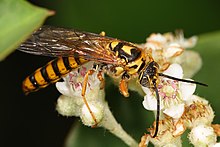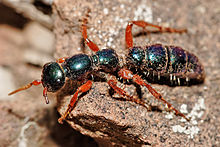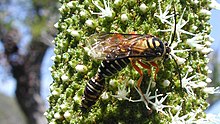| Thynnidae | |
|---|---|

| |
| Male Agriomyia sp. feeding on nectar | |
| Scientific classification | |
| Domain: | Eukaryota |
| Kingdom: | Animalia |
| Phylum: | Arthropoda |
| Class: | Insecta |
| Order: | Hymenoptera |
| Superfamily: | Thynnoidea |
| Family: | Thynnidae Shuckard, 1841 |
| Subfamilies | |
| |
The Thynnidae (also known as thynnid wasps, flower wasps, or thynnid flower wasps) are a family of large, solitary wasps whose larvae are almost universally parasitoids of various beetle larvae, especially those in the superfamily Scarabaeoidea. Until recently, the constituents of this family were classified in the family Tiphiidae, but multiple studies have independently confirmed that thynnids are a separate lineage.
Description
Most species are small, but they can be up to 30 mm long. The females of some subfamilies (Diamminae, Methochinae, and most Thynninae) are wingless and hunt ground-dwelling (fossorial) beetle larvae, or (in one species) mole crickets. The prey is paralysed with the female's sting, and an egg is laid on it so the wasp larva has a ready supply of food. In species where both sexes are winged, males are similar in size to the females, but are much more slender. The males of species with wingless females, however, are often much larger than the females and have wings; the adults mate in the air, with the female carried by the male's genitalia. Adults feed on nectar and are minor pollinators. As some of the ground-dwelling scarab species attacked by thynnids are pests, some of these wasps are considered beneficial as biological control agents.
Taxonomy
The family has five extant subfamilies, which were previously placed in Tiphiidae before it was found to be non-monophyletic. Thynnidae genera are classified as follows:




Extant genera
Subfamily: Anthoboscinae Turner, 1912
- Anthobosca Guérin-Ménéville, 1838
- Anthosila Genise, 1985
- Calchaquila Genise, 1985
- Cosila Guérin-Méneville, 1838
- Lalapa Pate, 1947
- Odontothynnus Cameron, 1904
- Paramyzine Berg, 1898
Subfamily: Diamminae Turner, 1907
- Diamma Westwood, 1835
Subfamily: Methochinae Rohwer, 1916
- Methocha Latreille, 1804
- Pterombrus Smith, 1869
Subfamily: Myzininae Borner, 1919
Tribe: Austromyzinini
- Austromyzinum Brown, 1985
- Cleftomyzinum Brown, 1985
Tribe: Myzinini
- Myzinum Latreille, 1803
Tribe: Mesini Argaman, 1994
Tribe: Meriini Costa, 1858
- Afromeria Boni Bartalucci, 2007
- Allomeria Boni Bartalucci, 2007
- Braunsomeria Turner, 1912
- Iswara Westwood, 1851
- Komarowia Radoszkowski, 1886
- Lamprowara Boni Bartalucci, 2004
- Macromeria Westwood, 1835
- Meria Illiger, 1807
- Meriodes Boni Bartalucci, 2007
- Myzinella Guiglia, 1959
- Notomeria Boni Bartalucci, 2011
- Parameria Guérin-Méneville, 1837
- Poecilotiphia Cameron, 1902
- Tamerlanella Boni Bartalucci, 2004
- Weerpaga Argaman, 1994
- Zezelda Argaman, 1994
Subfamily: Thynninae Ashmead, 1903
Tribe: Elaphropterini Kimsey, 1992
- Ammodromus Guérin-Méneville, 1838
- Argenthynnus Genise, 1991
- Atopothynnus Kimsey, 1991
- Brethynnus Genise,, 1991
- Chrysothynnus Turner, 1910
- Dolichothynnus Turner, 1910
- Elaphroptera Guérin-Ménéville, 1838
- Eucyrtothynnus Turner, 1910
- Merithynnus Kimsey, 1991
- Mesothynnus Kimsey, 1991
- Spilothynnus Ashmead, 1903
- Telephorornyia Guérin-Ménéville, 1838
- Upa Kimsey, 1991
- Zeena Kimsey, 1991
Tribe: Rhagigasterini Ashmead, 1903
- Aelurus Klug, 1840
- Curvothynnus Brown, 2010
- Dimorphothynnus Turner, 1910
- Eirone Westwood, 1844
- Rhagigaster Guérin-Ménéville, 1838
- Rugosothynnus Brown, 2015
- Umbothynnus Brown, 2008
Tribe: Scotaenini Kimsey,1992
- Anodontyra Westwood 1835
- Glottynnus Genise, 1991
- Glottynoides Kimsey, 1991
- Kaysara Carnimeo & Noll, 2018
- Ornepetes Guérin, 1838
- Pampathynnus Carnimeo & Noll, 2018
- Parelaphroptera Turner, 1910
- Pseudelaphroptera Ashmead, 1903
- Pseudoscotaena Carnimeo & Noll, 2018
- Rostrynnus Genise, 1991
- Scotaena Klug, 1810
Tribe: Thynnini
- Acanthothynnus Turner, 1910
- Aeolothynnus Ashmead, 1903
- Agriomyia Guérin-Ménéville, 1838
- Amblysoma Westwood, 1841
- Ariphron Kimsey, 2007
- Arthrothynnus Brown, 1996
- Aspidothynnus Turner, 1910
- Aulacothynnus Turner, 1910
- Belothynnus Turner, 1910
- Campylothynnus Turner, 1910
- Catocheilus Guérin-Ménéville, 1842
- Chilothynnus Brown, 1996
- Deuterothynnus Brown, 2010
- Doratithynnus Turner, 1910
- Dythynnus Kimsey, 2001
- Elidothynnus Turner, 1910
- Encopothynnus Turner, 1915
- Epactiothynnus Turner, 1910
- Guerinius Ashmead, 1903
- Gymnothynnus Turner, 1910
- Hathynnus Kimsey, 2003
- Heligmothynnus Brown, 2010
- Hemithynnus Ashmead, 1903
- Iswaroides Ashmead, 1899
- Leiothynnus Turner, 1910
- Lestricothynnus Turner, 1910
- Lophocheilus Guérin-Ménéville, 1842
- Macrothynnus Turner, 1908
- Megalothynnus Turner, 1910
- Neozeleboria Rohwer, 1910
- Oncorhinothynnus Salter, 1954
- Pentazeleboria Brown, 1983
- Phymatothynnus Turner, 1908
- Pogonothynnus Turner, 1910
- Psammothynnus Ashmead, 1903
- Rhytidothynnus Brown, 2008
- Tachynoides Kimsey, 1996
- Tachynomyia Guérin-Ménéville, 1842
- Tachyphron Brown, 1995
- Tmesothynnus Turner, 1910
- Thynnoides Guérin-Ménéville, 1838
- Thynnoturneria Rohwer, 1910
- Thynnus Fabricius, 1775
- Zaspilothynnus Ashmead, 1903
- Zeleboria Saussure, 1867
- Zythynnus Kimsey, 2001
Extinct genera
The following 4 genera are extinct members of Thynnidae:
Subfamily: Anthoboscinae Turner, 1912
- †Architiphia Darling, 1990
Subfamily: Methochinae Rohwer, 1916
- †Brachymethoca Zhang, 1989
Subfamily: Myzininae Borner, 1919
- †Geotiphia Cockerell, 1906
- †Lithotiphia Cockerell, 1906
References
- ^ Pilgrim, E.; von Dohlen, C.; Pitts, J. (2008). "Molecular phylogenetics of Vespoidea indicate paraphyly of the superfamily and novel relationships of its component families and subfamilies". Zoologica Scripta. 37 (5): 539–560. doi:10.1111/j.1463-6409.2008.00340.x. S2CID 85905070.
- Johnson, B.R.; et al. (2013). "Phylogenomics Resolves Evolutionary Relationships among Ants, Bees, and Wasps". Current Biology. 23 (20): 2058–2062. Bibcode:2013CBio...23.2058J. doi:10.1016/j.cub.2013.08.050. PMID 24094856.
- ^ Debevec, Andrew H.; Cardinal, Sophie; Danforth, Bryan N. (2012). "Identifying the sister group to the bees: a molecular phylogeny of Aculeata with an emphasis on the superfamily Apoidea" (PDF). Zoologica Scripta. 41 (5): 527–535. doi:10.1111/j.1463-6409.2012.00549.x. S2CID 33533180.
- Brothers, Denis J. (1993). "Key to subfamilies of Tiphiidae". In Goulet, Henri; Huber, John T. (eds.). Hymenoptera of the World, an Identification Guide to Families. Ottawa, Ontario: Centre for Land and Biological Resources Research. p. 178-185. ISBN 0-660-14933-8.
- Phillips, R.D.; Bohman, B; Brown, G.R.; Tomlinson, S.; Peakall, R. (2019). "A specialised pollination system using nectar-seeking thynnine wasps in Caladenia nobilis (Orchidaceae)" (PDF). Plant Biology. 22 (2): 157–166. doi:10.1111/plb.13069. PMID 31705712. S2CID 207964289.
- Brown, G. (2001). "Status of the Ariphron generic group (Hymenoptera: Tiphiidae): A critical review". Australian Journal of Entomology. 40 (1): 23–40. doi:10.1046/j.1440-6055.2001.00207.x.
- van Achterberg, Cornelis; van Harten, Antonius (2009). "Order Hymenoptera, family Thynnidae. Genera Lamprowara Boni Bartalucci, Iswara Westwood and Komarowia Radoszkowski (Hymenoptera: Thynnidae: Myzininae: Meriini)". Arthropod Fauna of the UAE. 2: 298–334. Retrieved September 8, 2023.
- Boni Bartalucci, Mario (2004). "Tribe-groups of the Myzininae with special regard to the palaearctic taxa of the tribe Meriini (Hymenoptera, Tiphiidae)" (PDF). Linzer Biologische Beiträge. 36 (2): 1205–1308. Retrieved September 8, 2023.
- Boni Bartalucci, Mario (2007). "The Afrotropical genera of the subtribe Meriina". Linzer Biologische Beiträge. 39 (2): 1257–1305. Retrieved September 8, 2023.
- Boni Bartalucci, Mario (2011). "Myzininae of the Old World. The subtribe Braunsomeriina (Hymenoptera: Tiphiidae)" (PDF). Linzer Biologische Beiträge. 43 (1): 363–380. Retrieved September 8, 2023.
- Kimsey, Lynn S. (2004). "Illustrated keys to genera of the male wasps in the subfamily Thynninae (Hymenoptera: Tiphiidae)". Proceedings of the Entomological Society of Washington. 106 (3): 571–585. Retrieved September 8, 2023.
- Carnimeo, Fernando Henrique (2021). Phylogenetic and biogeographic analysis of Elaphropterini (Hymenoptera, Tiphiidae, Thynninae) (PhD thesis). São José do Rio Preto: São Paulo State University. Retrieved September 8, 2023.
- Brown, Graham R. (2010). "Curvothynnus gen. nov. erected for two unusual species of thynnine wasps (Hymenoptera: Thynnidae: Thynninae: Rhagigasterini)". The Beagle Records of the Museums and Art Galleries of the Northern Territory. 26 (1): 89–96. doi:10.5962/p.287464.
- Brown, Graham R. (2015). "Rugosothynnus gen. nov. (Hymenoptera: Tiphiidae: Thynninae: Rhagigasterini), a newly recognised Australian genus". Zootaxa. 3925 (3): 361–386. doi:10.11646/zootaxa.3925.3.3. PMID 25781749.
- Carnimeo, Fernando Henrique; Noll, Fernando Barbosa (2018). "On the dumping ground genus Scotaena Klug, 1810 (Hymenoptera: Tiphiidae: Thynninae): Phylogeny, taxonomy and geographic distribution". Zootaxa. 4399 (4): 451–490. doi:10.11646/zootaxa.4399.4.1. hdl:11449/150542. PMID 29690290.
- Kimsey, Lynn S. (1992). "Phylogenetic relations among the South American thynnine tiphiid wasps (Hymenoptera)". Systematic Entomology. 17 (2): 133–144. Bibcode:1992SysEn..17..133K. doi:10.1111/j.1365-3113.1992.tb00326.x. S2CID 84978103.
- "Thynnidae". Paleobiology Database. Retrieved September 9, 2023.
External links
- Myzinum maculata Fabricius, a thynnid wasp on the UF / IFAS Featured Creatures Web site
 Media related to Thynnidae at Wikimedia Commons
Media related to Thynnidae at Wikimedia Commons
| Taxon identifiers | |
|---|---|
| Thynnidae | |